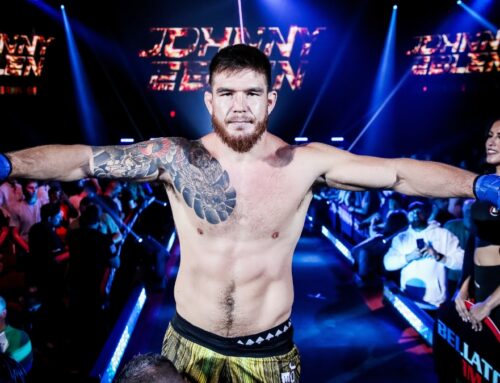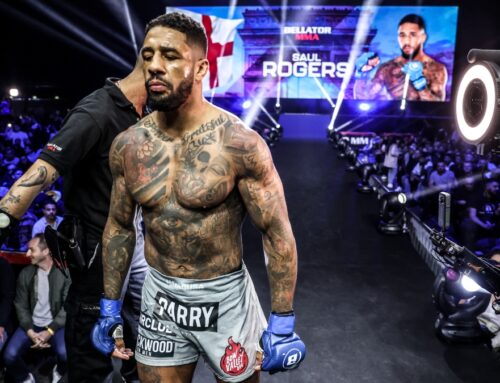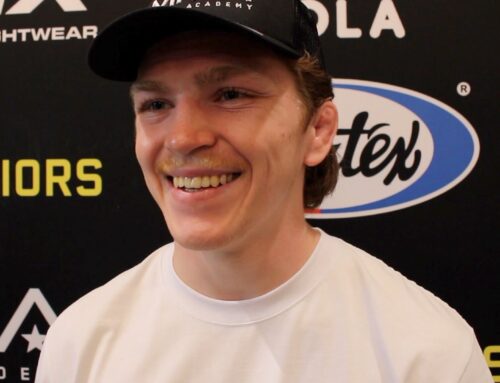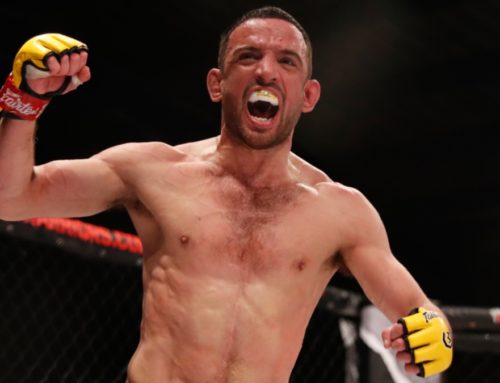As rampaging Australian middleweight contender Robert Whittaker edges closer and closer to a UFC title shot, Elliot Worsell checks in with George Sotiropoulos, a former lightweight contender from Melbourne who made his first UFC appearance some ten years ago.
Few names in mixed martial arts are as difficult to pronounce or spell as Sotiropoulos. It’s pou not po. It ends with los and not lous. Yet, for a while, between, say, 2008 and 2010, the name Sotiropoulos was on the very tip of MMA fans’ tongues. It was one said often, written often. It was one entered into the UFC lightweight title challenger sweepstakes. It even threatened to one day become a household name – well, in his native Australia at least.
“I once heard a comedian from Australia say if America can learn Schwarzenegger they can learn a Greek name,” says George Sotiropoulos. “He was right.”
Sotriopoulos is spoken and written less these days. That’s because George has been MIA from MMA since August 2014 and because his hot streak from 2008 to 2010, though promising and memorable, ultimately failed to deliver him the UFC title shot many had started to believe was inevitable. Not only that, Sotiropoulos, a globetrotter who for nine years resided Stateside, is now back home in Melbourne about to open a gym, which is to say slowing down, coming full circle.
“I’m at a point in my life where I’m looking to settle down,” Sotiropoulos, 39, explains. “I travelled for so many years training and competing. I had this goal where I just wanted to train in as many different places as I could that were renowned. And I did. It was a bit of the good, the bad and the ugly.
“But I don’t need to do that anymore. I think I’m as experienced as I’m going to get. I mean, you always learn new stuff, but it makes sense for me to have my own place. When it came to opening a place, I think I realised I wanted to come back to Australia and do it. But it took me a while to find a building and go through all the negotiations and the rigmarole. It’s a fun time for me now, though. It’s a new venture and I’m looking forward to starting it.”
That Sotiropoulos remains attached to something that has defined him and lifted his name comes as no real surprise. Nor is it a shock to hear of a return to the place where, at the age of 19, his mixed martial arts journey began on a random Friday night.
“I was at my friend’s house, doing our thing,” he recalls, “and my friend says, ‘George, I’ve got these fights from America. These guys fighting in cages.’ I’m like, ‘Put it on.’ He put it on and as soon as he put it on I was like, ‘What the fuck is this? It’s amazing.’”
Sotiropoulos, at the time, was doing a degree in banking and international trading. He was, therefore, about as far removed from being a fighter as an Australian teenager can be. Not that it mattered. Upon setting eyes on Royce Gracie and his unconventional way of manhandling bigger opponents and forcing them to tap, George was sold. Education, something he valued and continued, soon faded into insignificance.
“It was like the clouds parted, the heavens opened and God shone his light on me and that was it,” he explains. “I didn’t share it with too many people because they would have thought I was crazy, but I literally decided there and then, at 19, what I was going to do with my life.
“A couple of weeks later I walked to this Brazilian jiu-jitsu academy, only one of two in the country at the time, in my hometown. I thought, wow, this stuff is everywhere. Anyone can do it.
“I was at university and training jiu-jitsu. My schooling took precedence and I was working towards a degree. It was important to me to achieve that goal. But when I did it just didn’t compare to the goal of fighting. I was obsessed with that. It was all I could think about.”
Sotiropoulos wouldn’t turn professional as a mixed martial artist until 2004. Opportunities, he says, were anything but rife; early fights in Queensland led to assignments in far-flung places like Guam, Tokyo and Seoul. Indeed, it wasn’t until he emerged on season six of The Ultimate Fighter that the name Sotiroupoulos started to resonate among mixed martial arts aficionados.
Yet, such is the mind of the well-travelled, high-performing athlete, it’s not memories of time spent on The Ultimate Fighter or even subsequent UFC victories that linger. Instead, when asked to specify career highlights, Sotiropoulos’ mind goes back further. Much further. It goes back to quieter, purer times; times few people witnessed, much less remember.
“I don’t think people saw my best in the UFC,” he says. “There were fights I had that nobody saw. I had fights outside of the UFC where I performed really well.
“My two fights with Kyle Noke, for example, stand out. We spent a total of eight rounds fighting. That’s eight five-minute rounds. That’s forty minutes fighting. It was fun. He’s a very tough, durable fighter. With him, I basically displayed every facet of the game. I did things in that fight and fought in a way people haven’t seen from me since. I respect him. He showed me how durable he is. He’s one of the strongest guys I’ve fought. That guy is tough as nails.
“My other favourite fight was against a gentleman by the name of Sergio Lourenco. He was a Brazilian guy. I think he was a Royler Gracie student. He trained with Cesar Gracie, the Diaz brothers and Jake Shields. All that crew. He was tough. I fought him in Guam in January 2006. We had a really good fight. I really liked that fight because it brought out the best in me. I was in some trouble, some of the toughest positions I was ever in, but I proved a lot to myself. It was definitely a fight that left an impression on me. It was a battle, a fun fight. Enson Inoue was impressed. I met him that night and as a result of that fight he invited me to Japan to fight two Japanese guys. One was Shigetoshi Iwase and that was a good fight. I performed well. He was a tough guy. As Enson said, ‘He is no tomato can.’
“Then there was the fight with Shinya Aoki. That fight was kind of anticlimactic because it ended in a disqualification. He caught my foot, there was some battle to escape the foot-lock, and it ended as an anticlimax. There was a build-up and then nothing. I remember it feeling like a let-down.”
One thing Sotiropoulos did take from sharing a ring with Aoki, though, was a love of the rubber guard. It was something he saw his esteemed Japanese foe employ – many times, in fact – and something which would stay with George beyond their damp squib of a scrap in 2006.
“I had first seen Eddie Bravo using his guard techniques in 2001 when I attended Jean Jacques Machado’s academy in Los Angeles,” he says. “He was still in the formative stages of his jiu-jitsu but it looked very unorthodox and that appealed to me.”
The rubber guard was to become synonymous with Sotiropoulos due to his frequent use of it while on the UFC roster; it was a branch of his aggressive, suffocating grappling style, a style which saw him secure impressive wins against the likes of Joe Stevenson, Kurt Pellegrino and Joe Lauzon.
In 2010, during the UFC’s first venture into Australia, Sotiropoulos utilised a Stevenson takedown attempt in round two of their lightweight fight to showcase, in all its glory, the virtues of the rubber guard before a sold-out crowd of 17,000. Put on his back, George immediately reached for his left foot with his right hand, pulling it towards the shoulder of Stevenson, thus restricting the American’s wriggle room and chances of posturing up. Seconds later, George turned it into an omoplata attempt, a move soundtracked by a great roar, and was soon punching Stevenson in the face. Finally, with momentum now on his side, Sotriopoulos used the cage to reverse position and wind up on top of Stevenson in side-control.
Just. Like. That.
“I did very well during that period,” says George, who recorded six straight wins in the UFC. “I was in a very good frame of mind. I had great dedication and focus and was on a rise. I worked very diligently. I really enjoyed that period.
“I read the synopsis to this movie, Vision Quest, about a wrestler, and that was kind of what I was doing – I had a vision quest. I didn’t see the movie, I might have just read the synopsis, but the phrase stuck with me.”
He had a vision quest. He did very well. Emphasis on past tense, the assumption when a fighter begins to speak in these terms is that they are moving on with their life and that their new venture, be it the opening of a gym or something else, will herald the arrival of life phase two, three or four. This is true of Sotiropoulos, too. But what also becomes clear is how reluctant he is to leave phase one behind.
“I’m a martial artist for life and this is just another part of my martial arts journey,” he says.
“Do you consider yourself retired?” I ask.
“No,” he says, sounding almost affronted. “I don’t.”
Evidently, three years for Sotiropoulos constitutes an interval rather than the end credits and a run of five consecutive defeats serves to represent a dip in form as opposed to an indication of a fighter on the slide. It’s a positive, optimistic outlook, I suppose. The outlook of a fighter, some might say.
“If opportunities don’t arrive, preparation meets opportunities,” George continues. “That’s how I’ve always approached it. I’ve never had someone say, ‘Hey, do you want to fight for ten grand?’ That’s a very bad mindset. It doesn’t work that way. It works the other way round. You prepare, you prepare, you prepare. You go looking and those opportunities present themselves. That’s more my mindset.
“I would never go into anything underprepared. I wouldn’t accept anything if I wasn’t prepared. It wouldn’t even be a question. Well, unless Mr. (Dana) White came knocking on my door and said I’ll give you a hundred million dollars to fight so and so. That would be the exception to the rule. You’d have to be a fool to say ‘no’.”
It seems sensible to suggest that if a fighter wants to get out – truly get out – they need to create distance, essentially run away, from the sport to which they are drawn. But Sotiropoulos, suitably obsessed, a mixed martial artist, as he says, for life, is still immersed. The gym, the practices, the techniques, the students. For as long as this is his lifestyle, his universe, the thirst to fight will presumably remain unquenched.
“I love martial arts, I love fighting, I love training,” he says. “It’s something I got used to doing. Even before I was fighting I was always training for a fight and staying active. It’s definitely always on your mind. I exercise, I run, I lift, I do technique, I work on stuff. Not to the extent I once did – not to death – but it’s hard to stop completely.”
Keen to get down to it, keen to put a number on it, I ask Sotiropoulos, 14-7, how likely it is we’ll see him in a cage or ring again.
“Very possible,” he says. “Very, very possible.”
“A seventy-five percent chance?” I say.
He laughs. “That’s a good wager.”






